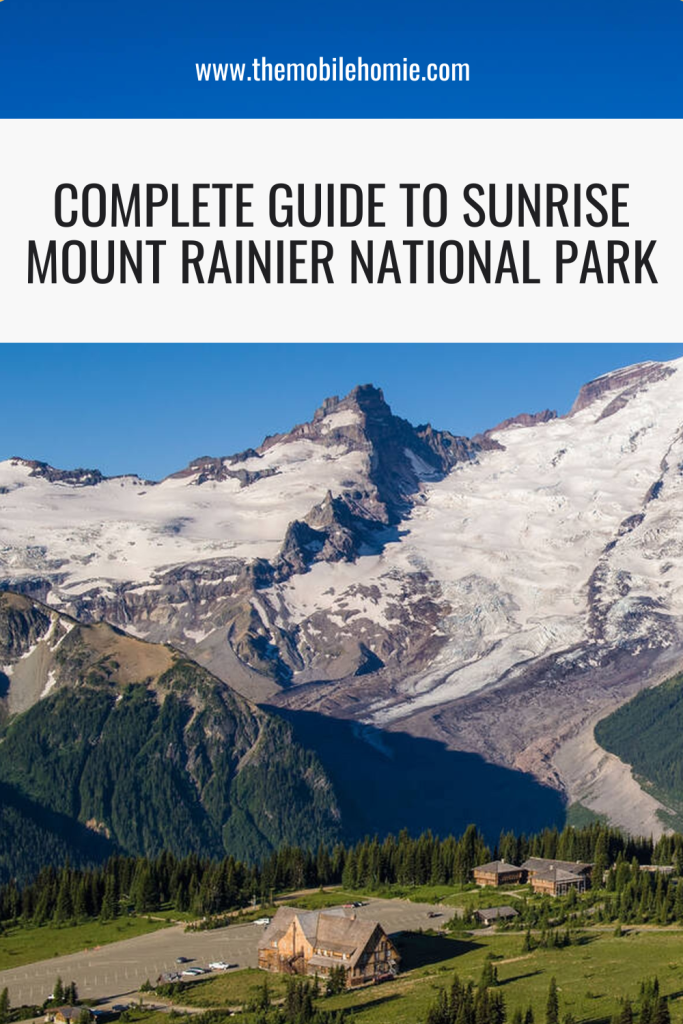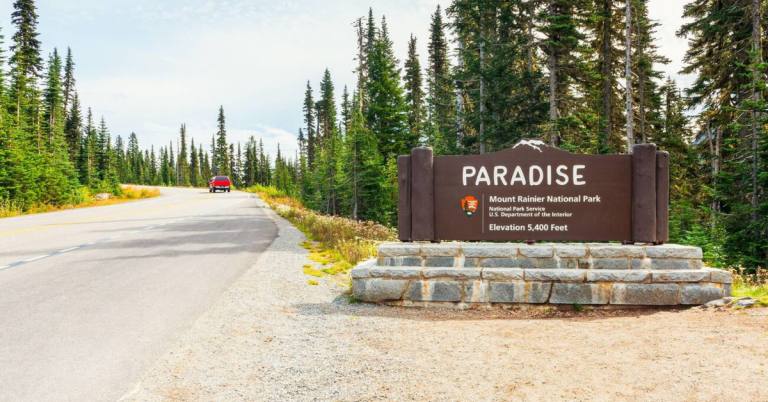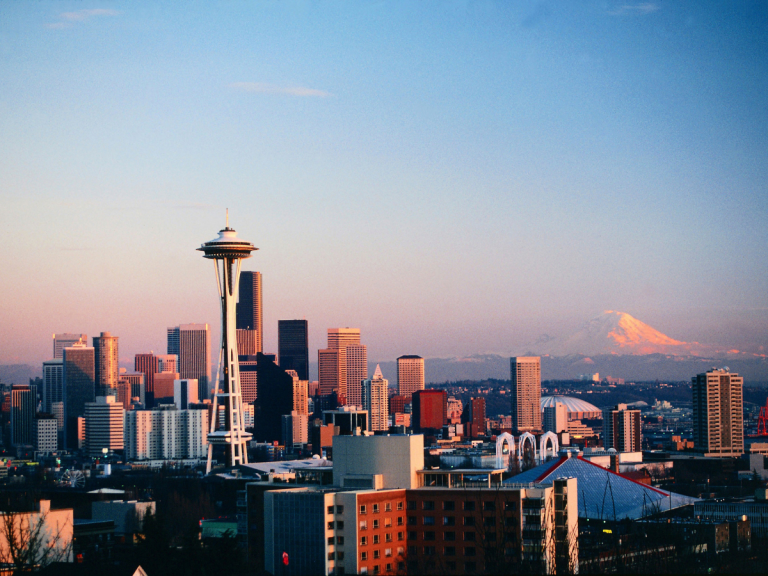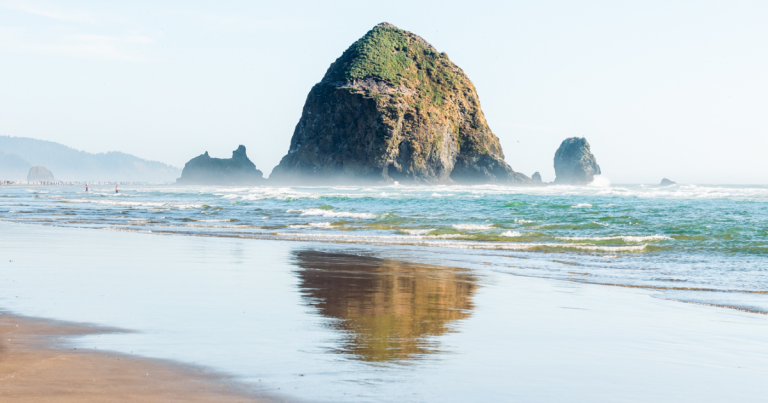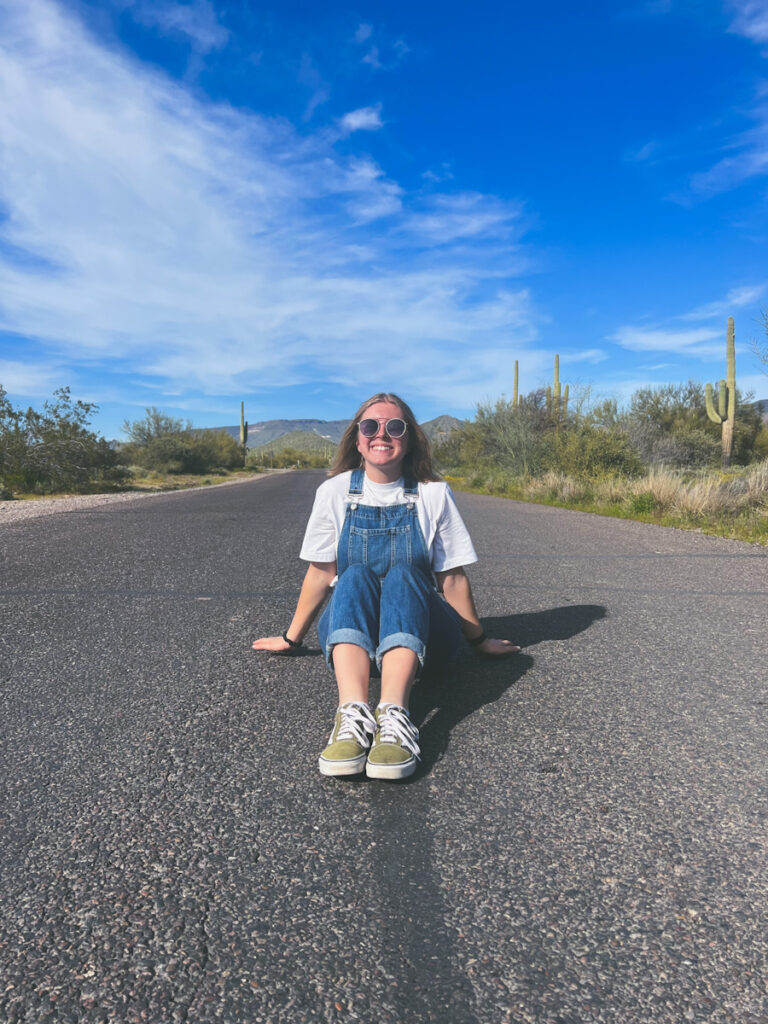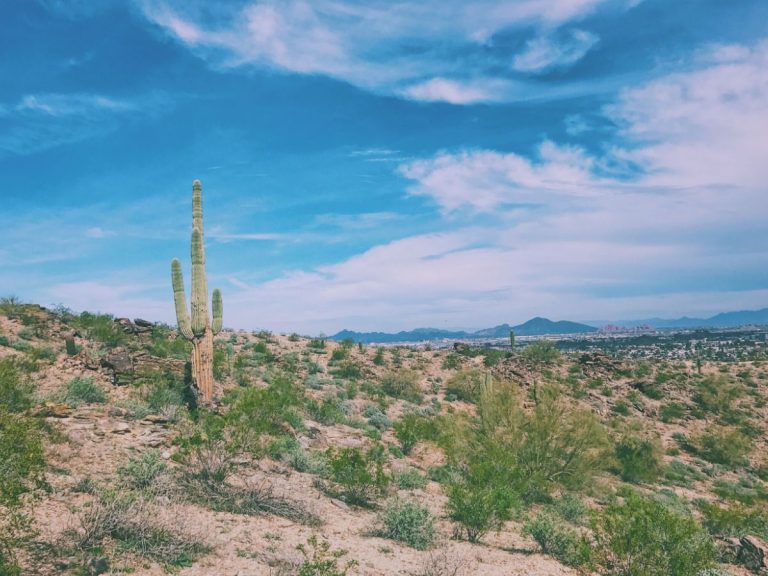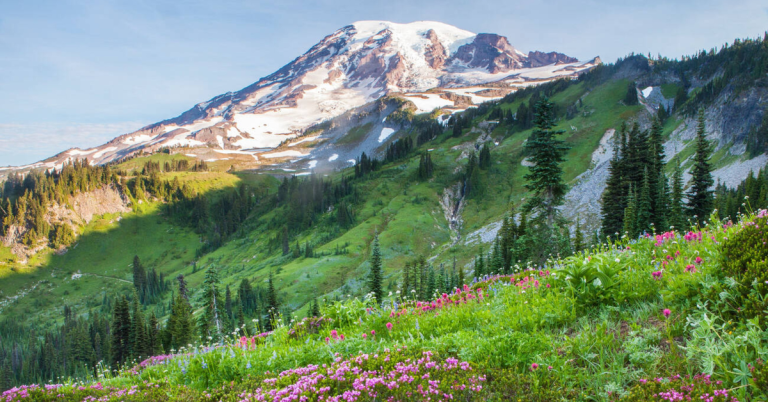Sunrise Mount Rainier National Park: Complete Guide
The Mobile Homie contains affiliate links and is a participant in the Amazon Services LLC Associates Program, as well as other affiliate programs. If you click on a link or make a purchase through one of these links, we may earn a small commission at no extra cost to you. For more details, see our Privacy Policy.
Welcome to Sunrise, Mount Rainier National Park’s crown jewel and the highest point you can reach by car in the National Park!
JT and I have spent countless mornings chasing that perfect sunrise moment here, and let me tell you — there’s something absolutely magical about this place that’ll get under your skin! After two unforgettable visits to Mount Rainier, we’ve learned the ins and outs of making the most of this alpine paradise.
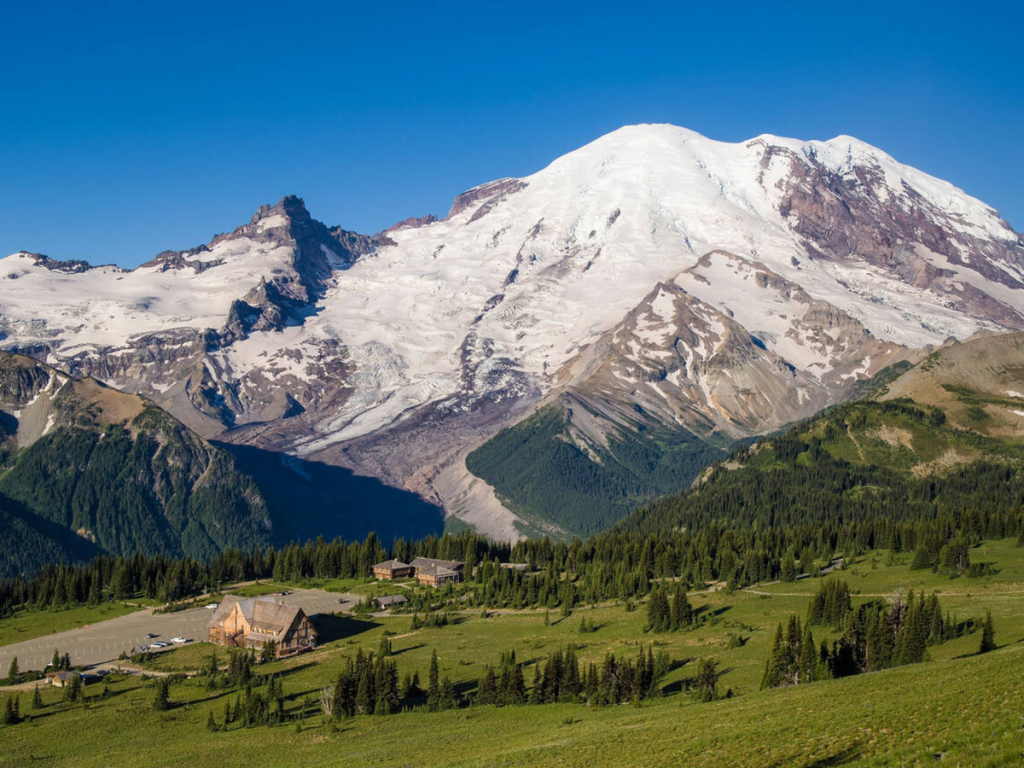
Whether you’re a first-time visitor wondering what all the fuss is about or someone planning your next Pacific Northwest adventure, this guide will give you everything you need to make the most of Sunrise Mount Rainier National Park.
Planning a longer Mount Rainier adventure? Check out our complete Mount Rainier 2-day itinerary that covers both Sunrise and Paradise areas in detail.
Why Sunrise Mount Rainier Should Be on Your Bucket List
Sunrise isn’t just another viewpoint. It’s nature’s amphitheater where the Pacific Northwest shows off its best moves! At 6,400 feet elevation, you’re literally above the clouds on clear days, with panoramic views that stretch across the Cascade Range and into the valleys below.
What makes this place so special? It’s the perfect storm of accessibility and wilderness! You can drive right up to incredible alpine scenery that would normally require serious backpacking elsewhere. Plus, the wildflower display from mid-July through early September is legendary among photographers and nature lovers alike.
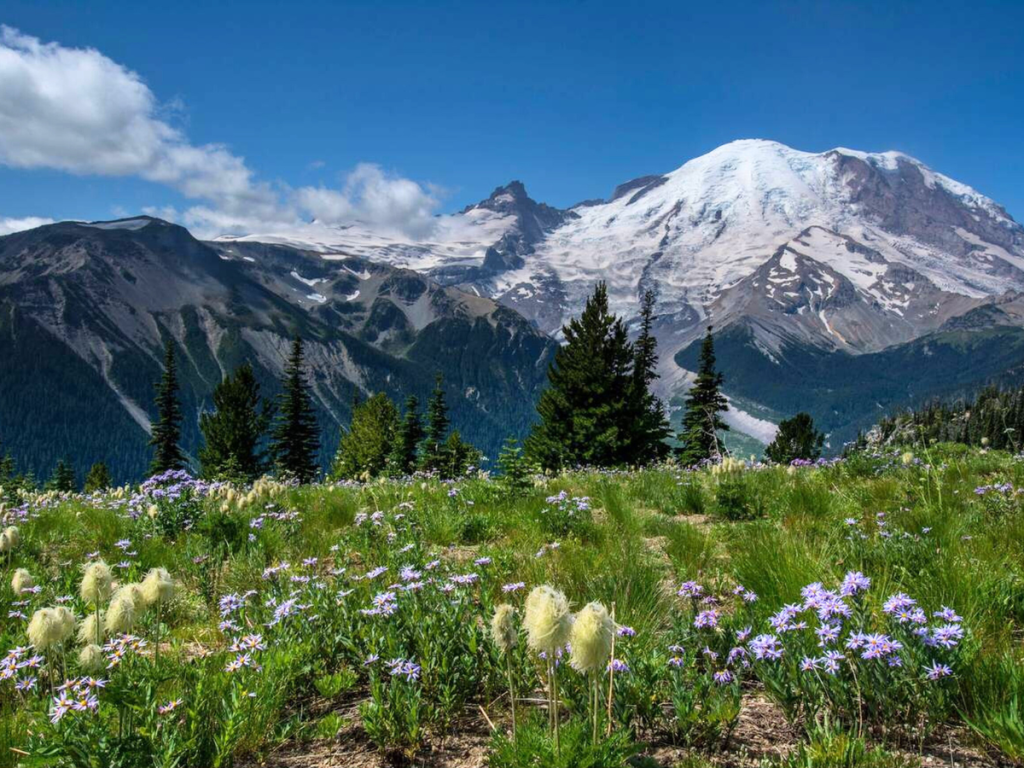
The area serves up a buffet of experiences: challenging hikes for the adventurous, gentle walks for families, wildlife viewing opportunities, and some of the best stargazing you’ll find in Washington State. It’s like having multiple national parks rolled into one incredible destination!
When to Visit: Timing Your Sunrise Mount Rainier Adventure
Here’s the reality check most visitors need: Sunrise is typically open from early July through mid-September due to seasonal road closures. That’s it. Roughly 10-12 weeks a year when this alpine paradise is accessible by car.
But here’s the insider scoop: those limited months are absolutely worth the wait! Peak Sunrise Mount Rainier wildflower season usually hits between mid-July and late August, when the subalpine meadows explode in color with lupine, Indian paintbrush, and dozens of other species.
Best Times Within the Season:
- Early July: Roads just opened, some snow patches remain, fewer crowds
- Mid-July to August: Peak wildflowers, warmest weather, busiest period
- September: Crisp air, fall colors beginning, lighter crowds
Weather at this elevation can be unpredictable. I’ve heard of snow in August and shorts-worthy days in late June! Always check current Sunrise Mount Rainier road conditions before heading up.
Navigating the Reservation System
Let’s talk about the elephant in the room: timed-entry reservations are required for Sunrise between 7 AM and 5 PM during summer. This caught many visitors off guard when it was implemented, but honestly? It’s made the experience so much better.
Here’s how to work the system:
- Reserve online at recreation.gov up to 90 days in advance
- Entry slots are available in 2 hour slots
- Early birds (before 7 AM) and late arrivals (after 5 PM) don’t need reservations
- Your reservation does not includes park entry if you don’t have an annual pass
Pro tip from our experience: The pre-7 AM slots are golden! On our first visit, JT and I arrived at 6:30 AM and practically had the place to ourselves until about 8:30. You’ll catch actual sunrise, have the trails mostly to yourself, and parking won’t be the nightmare it becomes later.
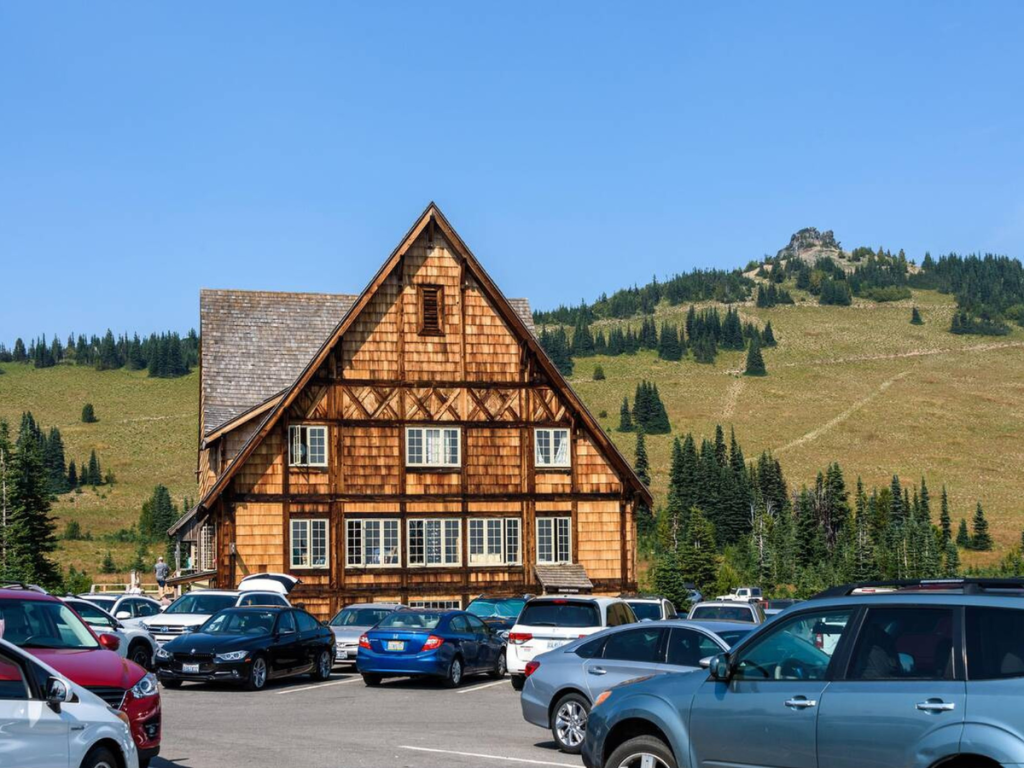
Getting There: Sunrise Parking and Access
The drive to Sunrise is half the adventure. You’ll take the White River entrance (not the Nisqually entrance that leads to Paradise), following Sunrise Road for about 15 winding miles through old-growth forest before emerging into alpine terrain.
Sunrise mount rainier parking fills up fast, and I mean fast. Even with the reservation system, arriving early is crucial. The main parking area holds about 200 cars, but on peak summer weekends, people start circling like vultures by 8 AM.
Parking Strategy:
- Arrive before 8 AM if possible
- Consider the overflow areas (short walk to visitor center)
- Weekdays are significantly less crowded
- Late afternoon visits (after 5 PM) often have better parking availability
Sunrise Visitor Center: Your Alpine Basecamp
The Sunrise Visitor Center Mount Rainier isn’t just a building. It’s your gateway to understanding this incredible ecosystem. Open seasonally (roughly July through September), it houses fascinating exhibits on glaciers, geology, and the unique alpine environment you’re exploring.
What you’ll find inside:
- Interactive glacier displays (seriously cool stuff about Mount Rainier’s 25 glaciers)
- Wildlife information and tracking maps
- Weather updates and trail conditions
- Ranger programs and guided walk schedules
- Clean restrooms (always appreciated at altitude!)
The adjacent Sunrise Day Lodge offers food, beverages, a gift shop, and those Instagram-worthy windows framing Mount Rainier perfectly. It’s also where you’ll find picnic areas and the main trailheads.
Best Hiking Trails at Sunrise Mount Rainier National Park
This is where Sunrise really shines! The trail network here offers everything from gentle nature walks to leg-burning climbs that’ll test your limits. Let me break down the best hiking trails at sunrise mount rainier based on what you’re looking for.
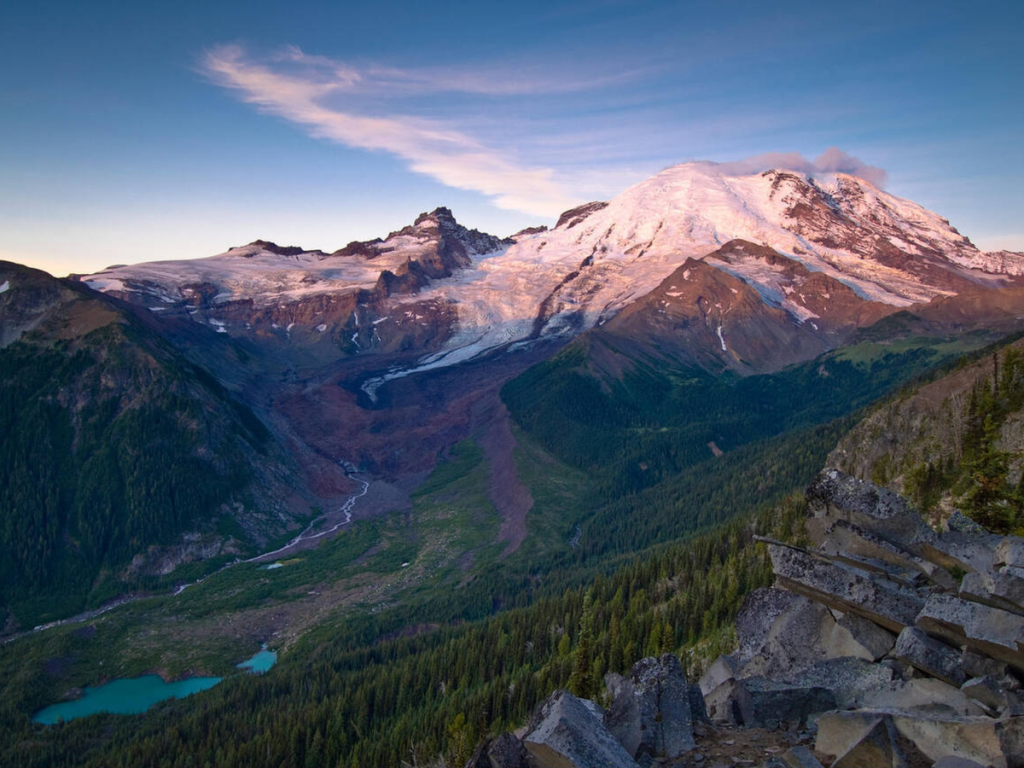
For Beginners and Families:
Sunrise Rim Trail (1.5 miles, easy) Perfect introduction to the area with killer views and minimal elevation gain. The trail loops around the visitor center area, offering multiple viewpoints and photo opportunities. Kids love spotting marmots and chipmunks along the way.
Silver Falls Trail (3 miles, moderate) A gentle descent through wildflower meadows to a 200-foot waterfall. The return is uphill but manageable for most fitness levels. Peak wildflower viewing happens here in late July.
For the Moderately Adventurous:
Mount Fremont Lookout (5.6 miles, moderate) This became our absolute favorite after two visits to Sunrise! During our first trip, we were honestly intimidated by the 5.6-mile distance, but JT convinced me it was worth trying. Best decision ever!
The trail climbs steadily through incredible wildflower meadows before reaching a historic fire lookout with 360-degree views. You’ll gain about 1,200 feet of elevation, but the payoff is worth it. On our second visit, we made this our priority hike and it didn’t disappoint. The views of Mount Baker and the Cascade Range are absolutely breathtaking!
Sourdough Ridge Trail (Various distances, moderate) Actually a network of interconnected trails that can be customized to your energy level. The full ridge walk offers stunning views of Mount Baker, Glacier Peak, and of course, Rainier herself.
For Serious Hikers:
Burroughs Mountain Trail (7+ miles, strenuous) The crown jewel of sunrise mount rainier hiking. This challenging trail takes you onto the actual slopes of Mount Rainier, with close-up views of glaciers and some of the most dramatic alpine scenery in Washington. Experienced hikers will find it unforgettable!
Sunrise to Tipsoo Lake (Various routes, moderate to strenuous) Multiple trail combinations connect Sunrise to the beautiful Tipsoo Lake area, creating options for everything from day hikes to overnight backpacking trips.
Wildlife Viewing at Sunrise
The sunrise mount rainier wildlife viewing opportunities are honestly mind-blowing! This alpine environment supports a surprising diversity of animals, many of which you’ll actually see if you know where to look.
What You’re Likely to Spot:
Mountain Goats: These sure-footed climbers are the stars of the show. Look for them on rocky outcrops and steep slopes, especially early morning and late afternoon.
Olympic Marmots: These giant ground squirrels are everywhere around Sunrise. You’ll hear their distinctive whistles echoing across the meadows as they warn each other about approaching humans.
Hoary Marmots: Larger cousins of the Olympic variety, often sunbathing on rocks near the visitor center.
Pika: Listen for their high-pitched calls among the boulder fields. These tennis ball-sized relatives of rabbits are perfectly adapted to the harsh alpine environment.
Birds: Golden eagles, hawks, Clark’s nutcrackers, and various alpine species make their home here.
Black Bears: Occasionally spotted, especially in late summer when they’re bulking up for winter. Always maintain safe distances and follow park guidelines.
Wildlife Viewing Tips:
- Early morning and late afternoon are prime times
- Bring binoculars for distant animals
- Never approach or feed wildlife
- Make noise when hiking to avoid surprising animals
- Check with rangers for recent wildlife activity reports
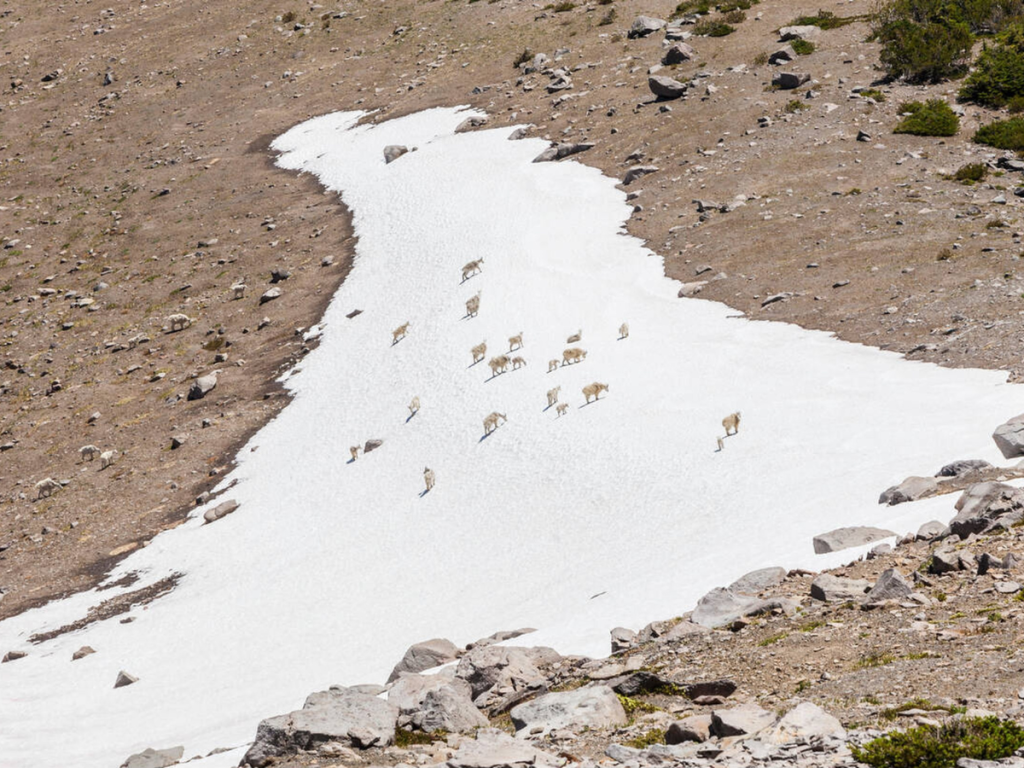
Sunrise vs Paradise: Which Should You Choose?
This is probably the most common question I get from first-time Mount Rainier visitors. Both areas are incredible, but they offer completely different experiences.
| Aspect | Sunrise | Paradise |
|---|---|---|
| Elevation | 6,400 feet | 5,400 feet |
| Season | July-September only | Year-round access |
| Crowds | Moderate (with reservations) | Heavy, especially summer |
| Hiking | Alpine/subalpine terrain | Mix of forest and alpine |
| Wildflowers | Spectacular but brief | Longer season, different varieties |
| Views | Dramatic, close to mountain | Classic postcard angles |
| Facilities | Seasonal visitor center | Year-round visitor center |
| Best For | Serious hikers, wildflower lovers | Families, winter activities |
Our honest take after experiencing both areas twice? If you’re visiting during Sunrise’s open season and love alpine environments, choose Sunrise! The experience is more intimate and wild.
Paradise is amazing but can feel like a theme park on busy summer days. JT and I actually visited Paradise on our first Mount Rainier trip, then discovered Sunrise on our second visit—and we haven’t looked back since!
For a comprehensive comparison and detailed itineraries covering both Sunrise and Paradise, check out our complete Mount Rainier 2-day guide.
Photography at Sunrise Mount Rainier
Let’s be real—you’re going to take a million photos here, and for good reason. Sunrise mount rainier photography spots are legendary among landscape photographers.
Best Photography Locations:
Sunrise Point: Classic sunrise shots with Mount Rainier perfectly framed Fremont Lookout: 360-degree panoramas including Mount Baker and Glacier Peak
Sourdough Ridge: Wildflower foregrounds with mountain backdrops Frozen Lake: Reflection shots when the water is calm Burroughs Mountain: Close-up glacier and crevasse details
Photography Tips:
- Golden hour (sunrise and sunset) offers the best light
- Bring a polarizing filter for clearer mountain views
- Wildflower season provides incredible macro opportunities
- Don’t forget the wide-angle lens for those sweeping vistas
- Check weather forecasts—clear days after storms often provide the most dramatic shots
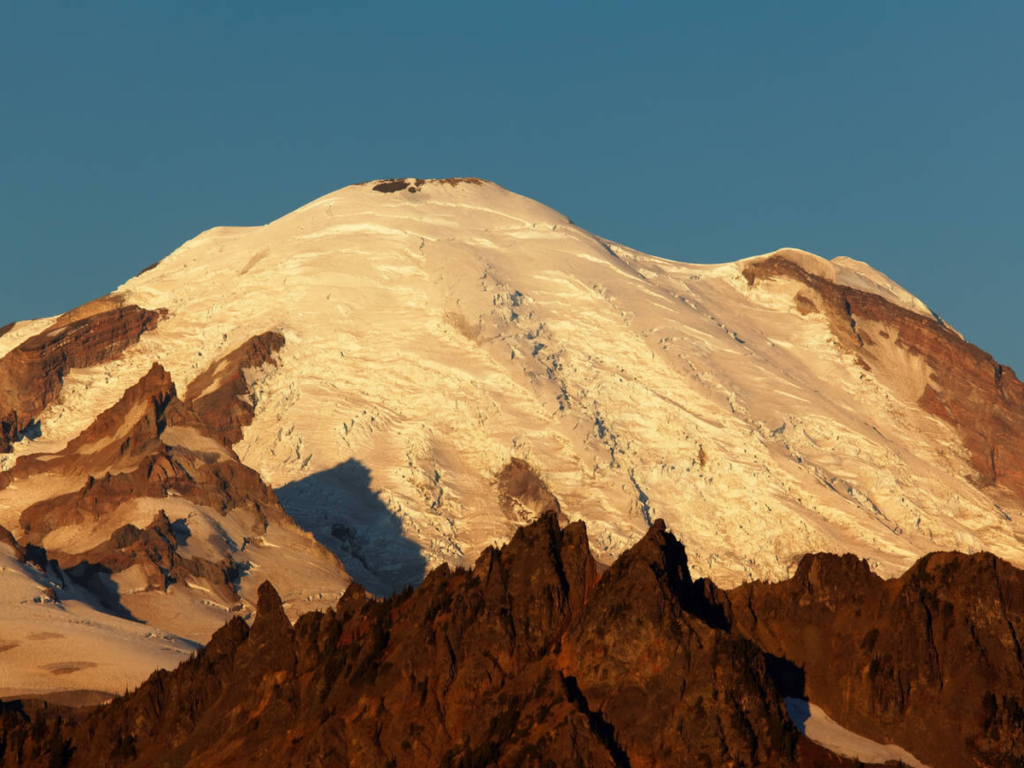
Essential Gear for Your Sunrise Adventure
The mountain weather at 6,400 feet elevation can change faster than your mood on a Monday morning. Here’s what you absolutely need for a safe and comfortable visit:
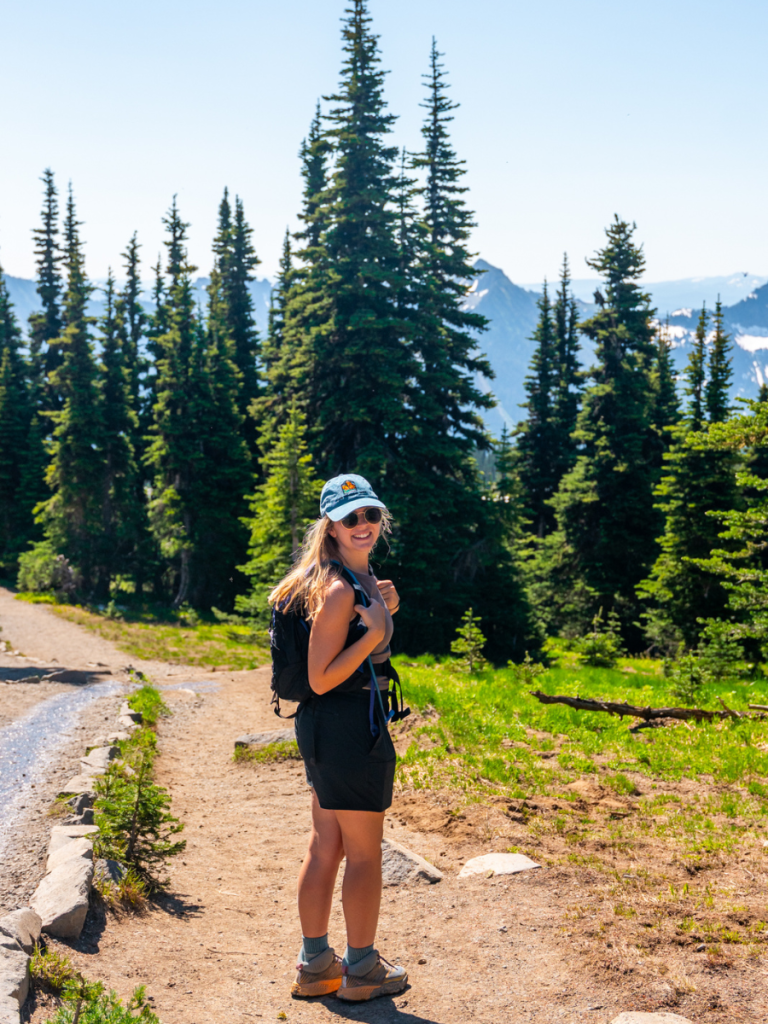
Layer Game Strong:
- Base layer: Moisture-wicking materials (avoid cotton!)
- Insulating layer: Down or synthetic jacket for temperature drops
- Shell layer: Waterproof/windproof outer layer
- Extra layers: Temperature can drop 30+ degrees from day to night
Footwear:
- Sturdy hiking boots with ankle support. I’ve been wearing the Hoka Kaha 3 GTX Hiking Boots this season and have been LOVING them!
- Microspikes or light traction for early season snow patches
- Comfortable camp shoes for relaxing at the visitor center
Day Pack Essentials:
- Plenty of water (altitude increases dehydration risk) – We love the Hydro Flask 32 oz Water Bottle to keep fluids cold during long hikes
- High-energy snacks (your body works harder at altitude)
- Sun protection (UV is intense at elevation) – Don’t skip Sunscreen SPF 50 for high elevation protection
- First aid supplies
- Map and compass (cell service is spotty) – The Mount Rainier National Park Trail Map is essential for navigation and planning
- Headlamp for early starts or late finishes – The Petzl Tikka Headlamp is perfect for those pre-dawn hikes
Where to Stay Near Sunrise
Here’s the thing about Sunrise Mount Rainier Camping. There are no overnight accommodations directly at Sunrise. But you’ve got several solid options nearby!
Camping Options:
White River Campground (5 miles from Sunrise)
- 112 sites, first-come-first-served
- Open July through September
- Basic facilities, vault toilets
- Perfect for early morning Sunrise access
Ohanapecosh Campground (45 minutes drive)
- 188 sites, reservations available
- Has been closed for the 2025 season, but typically open May through September
- More amenities, hot springs nearby
Silver Springs Campground (Crystal Mountain area)
- Private campground with full hookups
- About 30 minutes from Sunrise entrance
- Showers and camp store available
Lodging Options:
Crystal Mountain Resort (30 minutes)
- Hotel rooms and vacation rentals
- Summer chairlift rides for additional views
- Restaurant and amenities
Enumclaw/Greenwater Area (45-60 minutes)
- Various motels and B&Bs
- More dining options
- Good base for multiple park visits
Looking for more accommodation options and detailed logistics? Our Mount Rainier 2-day itinerary includes comprehensive lodging recommendations for every budget.
Getting to Mount Rainier from Seattle Most visitors fly into Seattle-Tacoma International Airport, making the 2.5-hour drive to Mount Rainier’s Sunrise area. If you’re planning to explore Seattle before or after your mountain adventure, consider spending a few days in the Emerald City to experience everything from Pike Place Market to the Space Needle.
Planning to visit Seattle too? Our 3-day Seattle travel guide covers all the must-see attractions and hidden gems perfect for first-time visitors.
Seasonal Activities Beyond Hiking
Sunrise Mount Rainier summer activities extend far beyond just hiking. This alpine playground offers diverse experiences for different interests!
Wildflower Enthusiasts:
- Peak bloom: Mid-July through early August
- Best meadows: Paradise Park, Grand Park area
- Photography workshops: Often available through park programs
- Botanical walks: Ranger-led programs identifying alpine species
Stargazing:
Sunrise’s high elevation and remote location make it one of Washington’s premier dark sky locations. On clear nights, the Milky Way stretches across the sky like nature’s own light show. JT and I both agree, Sunrise Mount Rainier has some of the best stargazing in the USA!
Best stargazing spots:
- Sunrise Point (away from visitor center lights)
- Sourdough Ridge
- Any of the higher elevation trail areas
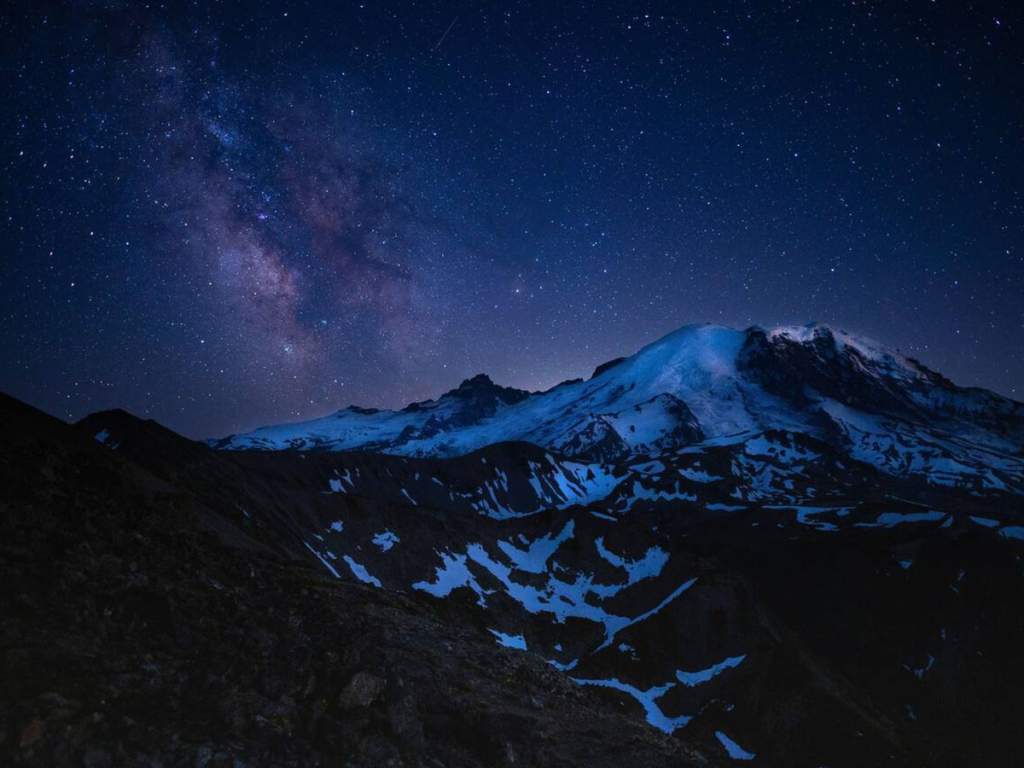
Educational Programs:
- Ranger talks: Usually held at the visitor center amphitheater
- Guided walks: Various themes from geology to wildlife
- Junior Ranger programs: Great for families with kids
- Evening programs: Occasional special events during peak season
Weather and What to Expect
The weather at Sunrise Mount Rainier is notoriously unpredictable. Between our two visits, JT and I have experienced everything from shorts-and-t-shirt weather to a surprise afternoon thunderstorm that had us scrambling for cover.
On our first trip in early August, we started the day in fleece jackets and ended up in tank tops by noon. Our second visit in late June was completely different — overcast and cool all day, but the moody lighting made for incredible photos! Here’s what you need to know:
Typical Conditions by Month:
July:
- Daytime: 60-75°F
- Nighttime: 35-45°F
- Snow patches common early in month
- Road may have recent opening restrictions
August:
- Daytime: 65-80°F
- Nighttime: 40-50°F
- Peak season weather
- Afternoon thunderstorms possible
September:
- Daytime: 55-70°F
- Nighttime: 30-40°F
- Crisp, clear days common
- Early snowfall possible
Weather Preparedness:
- Check forecasts from multiple sources
- Be prepared for rapid changes
- Afternoon thunderstorms develop quickly
- Snow possible any time of year
- Frost common in early morning, even summer
Family-Friendly Options
Are you wondering about family friendly hikes at Sunrise Mount Rainier? While Sunrise is more challenging than Paradise, plenty of options work great for families with properly prepared kids.
Best Family Trails:
Sunrise Rim Trail: Short, mostly level, amazing views. Perfect for kids who need frequent stops for snack breaks and marmot spotting.
Silver Falls (partial): The first mile through wildflower meadows is manageable for most kids. Turn around before the steep descent if needed.
Nature trails near visitor center: Several short interpretive loops perfect for little legs and short attention spans.
Family Tips:
- Start early to avoid crowds and heat
- Pack extra snacks and water
- Bring layers
- Plan for frequent rest stops
- Make it an adventure, not a forced march
- Consider the visitor center programs designed for families
Planning Your Day: Sample Itineraries
The Early Bird Special (Recommended):
- 5:30 AM: Arrive at Sunrise (no reservation needed)
- 6:00 AM: Watch actual sunrise from Sunrise Point
- 7:00 AM: Breakfast at Day Lodge
- 8:00 AM: Start Mount Fremont Lookout hike
- 12:00 PM: Return, lunch, explore visitor center
- 2:00 PM: Easy afternoon stroll on Sunrise Rim Trail
- 4:00 PM: Head home, beat traffic
The Casual Explorer:
- 10:00 AM: Arrive with reservation
- 10:30 AM: Visitor center and exhibits
- 11:30 AM: Sourdough Ridge Trail (partial)
- 1:00 PM: Lunch and rest at Day Lodge
- 2:30 PM: Silver Falls Trail or nature walks
- 4:30 PM: Departure
The Serious Hiker:
- 6:00 AM: Early arrival, quick breakfast
- 6:30 AM: Start Burroughs Mountain Trail
- 2:00 PM: Return, late lunch
- 3:30 PM: Quick visitor center visit
- 4:30 PM: Departure (or camp nearby for next day)
Insider Tips for Your Visit
After two years of Sunrise visits, here are the insider secrets that’ll make your trip smoother!
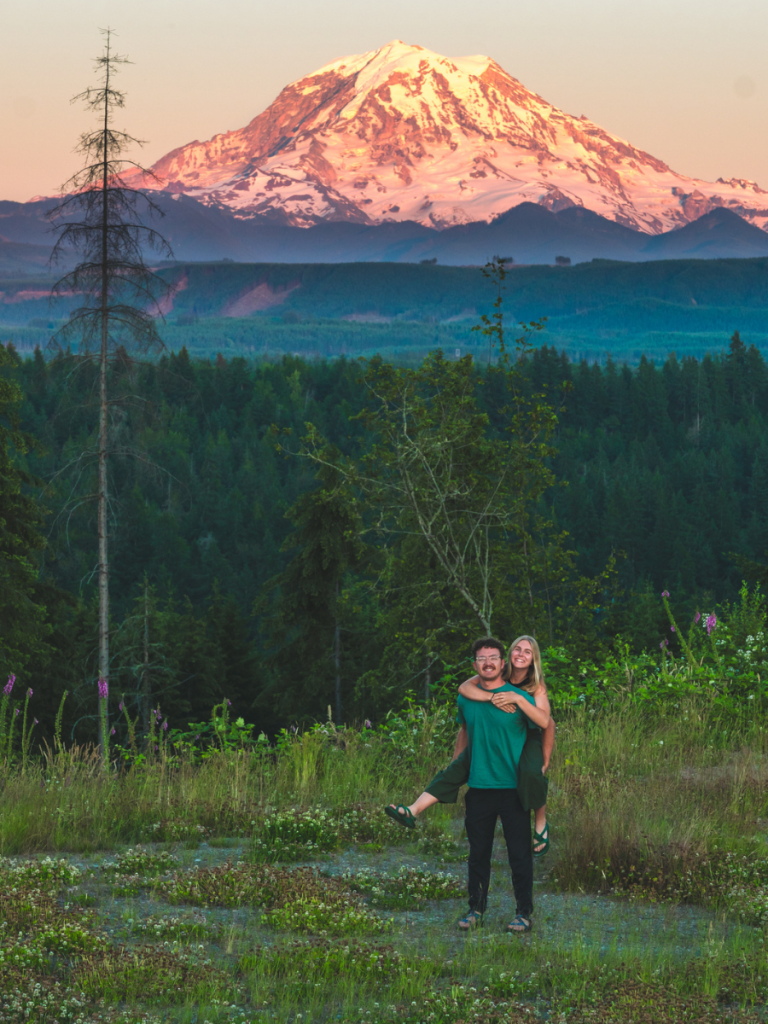
How to Deal with the Crowds:
- Weekdays are magic: Seriously, if you can swing it, Tuesday through Thursday visits are like having the place to yourself! Our Tuesday visit was so peaceful compared to our Saturday experience.
- Late afternoon visits: After 3 PM, crowds thin out significantly and parking becomes available
- Weather works in your favor: Partly cloudy days keep casual visitors away but often provide the most dramatic photography conditions. We learned this firsthand when a cloudy forecast kept crowds away but gave us some of our best mountain shots!
Trail Tips:
- Check recent trip reports: AllTrails, WTA.org, and park websites have current conditions
- Start counterclockwise on loop trails: Most people go clockwise, so you’ll have better photo opportunities going the other way. JT figured this out on our second visit and we had Sourdough Ridge practically to ourselves!
Photography Tips:
- Blue hour is underrated: That period just after sunset provides incredible alpenglow shots
- Storm clearing conditions: Some of the most dramatic shots happen when weather is breaking up
- Wildflower macro opportunities: Don’t just shoot the mountain — the alpine flowers are incredible subjects too!
Safety Considerations
Here’s what you need to know to stay safe during your Sunrise Mount Rainier adventure:
Altitude Awareness:
- 6,400 feet can affect some people
- Drink extra water
- Take breaks if feeling dizzy or nauseous
- Recognize early altitude sickness symptoms
Weather Hazards:
- Hypothermia risk even in summer
- Lightning danger during afternoon storms
- Sudden fog can disorient hikers
- Snow patches can be slippery and hide trail markers
Trail Safety:
- Stay on designated trails (fragile alpine environment)
- Carry navigation tools
- Tell someone your plans
- Start early to avoid afternoon weather
- Know your limits—mountain rescue is expensive and dangerous
Conservation and Leave No Trace
This incredible place exists because people before us cared enough to protect it. Here’s how to ensure sunrise mount rainier remains pristine for future generations:
Alpine Environment Protection:
- Stay on trails: Alpine plants grow incredibly slowly and are easily damaged
- Pack out all trash: Including organic waste like apple cores
- Don’t move rocks: Pika and other animals depend on rock structures
- Observe wildlife from distance: Don’t approach for photos
- Most importantly: LEAVE NO TRACE!
Wildflower Etiquette:
- Look, don’t pick: Flowers are for everyone to enjoy
- Don’t trample for photos: Stay on designated areas
- Use existing trails: Don’t create new paths through meadows
Final Thoughts: Why Sunrise Will Capture Your Heart
There’s something about standing at 6,400 feet with Mount Rainier looming above you that puts life in perspective. Maybe it’s the thin air, or the way wildflowers seem to glow in the alpine light, or the profound silence broken only by marmot whistles and distant glacier groans.
After two visits, JT and I keep finding ourselves planning our next return trip before we’ve even left the parking lot! There’s always another trail to explore, another sunrise to catch, another meadow of wildflowers to discover.

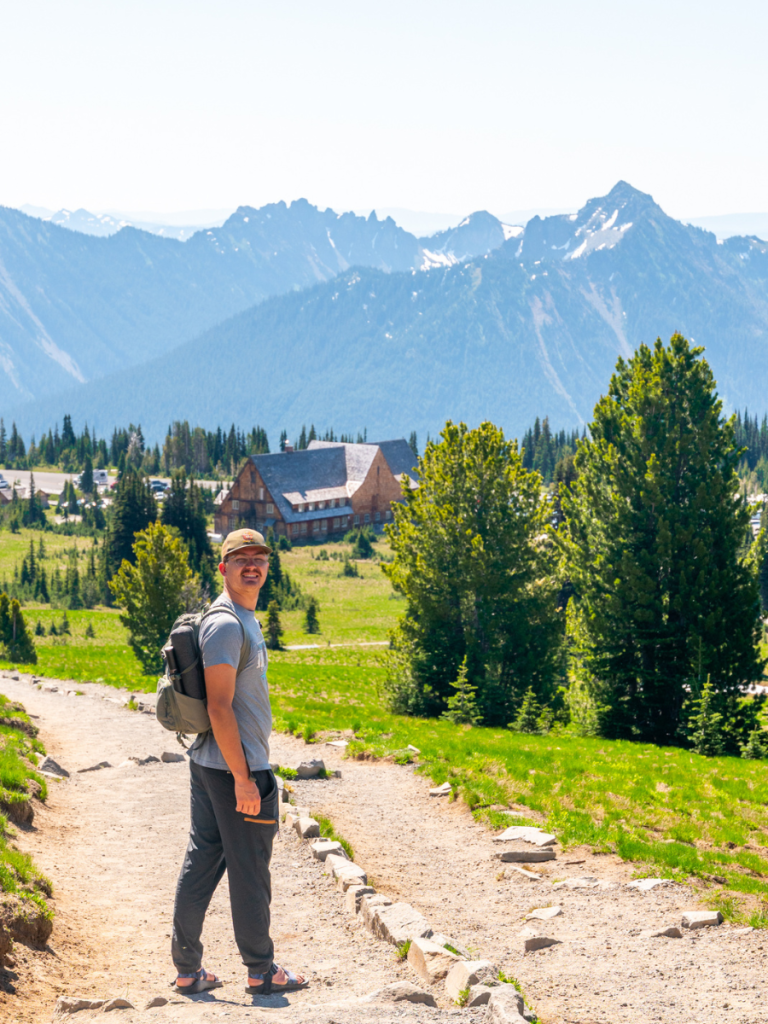
Sunrise Mount Rainier National Park isn’t just a destination, it’s a reminder of what we’re capable of protecting when we work together! Every visit feels like a privilege, a chance to witness one of the Pacific Northwest’s most spectacular natural shows.
Whether you’re seeking challenging hikes, gentle wildflower walks, wildlife viewing, or simply a place to breathe deeply and remember what matters, Sunrise delivers in ways that’ll stay with you long after you’ve descended back to sea level.
The mountains are calling, and Sunrise is answering. Your alpine adventure awaits! Just remember to make those reservations, pack your layers, and prepare for an experience that’ll redefine what you think possible in a national park.
Ready to plan your Sunrise adventure? Check current road conditions, make your reservations, and get ready for one of the most spectacular experiences the Pacific Northwest has to offer! Trust us, this is one destination that’ll exceed every expectation you have.
Mount Rainier is just one highlight of the incredible Pacific Northwest. If you’re planning a bigger regional adventure, don’t miss our 7-day Pacific Northwest road trip itinerary that includes Mount Rainier along with Olympic National Park, the Oregon Coast, and other epic stops.
What questions do you have about visiting Sunrise Mount Rainier National Park? Share your experiences or ask for specific advice in the comments below!
